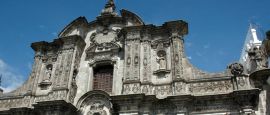Ecuador Weather, climate and geography
Weather & climate
Ecuador's climate varies widely due to its geography, with distinct patterns in the coastal region, the Andes, the Amazon and the Galápagos Islands. Because the country lies on the equator, temperatures remain fairly stable throughout the year, and seasons are typically defined by rainfall rather than temperature changes.
The coast experiences a warm, tropical climate. From December to May, the weather is hot and humid with frequent showers, and temperatures range from 25–32°C (77–90°F). From June to November, the climate becomes cooler and drier, with temperatures around 20–28°C (68–82°F). Ocean conditions also change seasonally, affecting beach and surfing activities.
The Andes have a cooler, spring-like climate year-round, with temperature dependent on altitude. Cities such as Quito and Cuenca enjoy daytime temperatures of 15–22°C (59–72°F) and much cooler nights, often dropping to 7–10°C (45–50°F). Rain is more common from October to May, and clear, dry weather dominates from June to September.
The Amazon region is hot, humid and rainy throughout the year, with temperatures typically between 25–32°C (77–90°F). Rainfall is frequent, especially from March to July, though brief sunny spells occur daily. The humidity and dense forest environment make the Amazon feel consistently warm.
The Galápagos Islands have a mild, semi-tropical climate. The warm season from December to May brings temperatures of 26–30°C (79–86°F) with occasional rain, while the cooler season from June to November sees temperatures drop to 21–25°C (70–77°F) with cloudier skies and nutrient-rich waters that attract marine life. Conditions are comfortable year-round, making the islands a popular destination in any season.
Ecuador's varied geography means clothing needs differ between regions. Lightweight, breathable clothing is suitable for the coastal areas, the Amazon and the Galápagos Islands, where temperatures are warm and humidity can be high. Sun protection is important throughout the country, especially at the equator.
In the Andes, temperatures are cooler year-round, and visitors should bring layers that can be added or removed as conditions change. Even when daytime weather is mild, evenings can become cold at higher altitudes, so a warm jumper or jacket is useful. Rainfall is common in many highland areas, particularly from October to May, making a compact waterproof jacket or poncho advisable.
For the Amazon, long sleeves and long trousers help protect against insects, and quick-drying fabrics are practical in humid conditions. Sturdy shoes or hiking boots are useful for jungle walks or highland treks, while comfortable walking shoes are suitable for cities and lighter excursions.
When visiting churches or religious sites, modest clothing is appreciated. Swimwear is appropriate only at beaches, pools and designated natural areas.
Overall, packing a combination of lightweight clothing, warm layers and reliable rain protection ensures comfort across Ecuador's contrasting climates.
Geography
Ecuador may be small in size, but it is one of the world's most geographically diverse countries. Straddling the equator on the northwest shoulder of South America, it encompasses four distinct regions: the Coast, the Highlands, the Amazon and the Galápagos Islands. Each offers striking landscapes and its own climate, wildlife and cultural traditions.
The Andes form the backbone of the country, running north to south through the central highlands. This region is characterised by dramatic volcanoes, deep valleys and high plateaus. Several peaks exceed 5,000 metres, including Chimborazo and Cotopaxi, whose snow-capped cones dominate the skyline. Many of Ecuador's major cities, such as Quito and Cuenca, sit among these mountains.
To the west, the coastal lowlands stretch along the Pacific Ocean. This region features fertile plains, mangrove forests, long beaches and warm tropical weather. Cities like Guayaquil and Manta lie here, along with popular surf towns and fishing villages.
The Amazon Basin lies to the east, a vast expanse of rainforest threaded with rivers and home to exceptional biodiversity. The region's communities, wildlife and ecosystems are among the richest in South America. Despite its remote feel, several areas are accessible via river transport or flights from Quito.
Nearly 1,000 kilometres offshore, the Galápagos Islands form Ecuador's most famous natural treasure. This volcanic archipelago is renowned for its unique species and evolutionary significance, offering visitors a rare chance to experience wildlife unconcerned by human presence.
Do you have any Feedback about this page?
© 2025 Columbus Travel Media Ltd. All rights reserved. No part of this site may be reproduced without our written permission, click here for information on Columbus Content Solutions.




 You know where
You know where